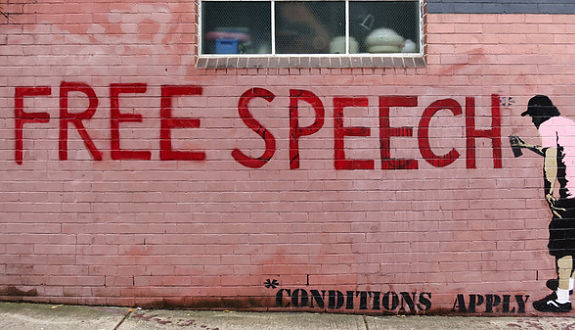
Free speech has been in the news in a big way this week. Between the NFL protests, to Trump’s less-than-diplomatic comments regarding said protests, to Berkeley’s canceled “free speech” week, we’ve been hearing about the First Amendment and free speech a lot. But apparently, a study on college students shows that no one understands the First Amendment (although the validity of this study has been debated). This post is designed to give you an overview of the tradition of free speech and the First Amendment, so (at the very least) you don’t sound like an idiot on Facebook.
Let’s start with the basics. The First Amendment guarantees freedom of speech, freedom of the press, freedom of assembly, freedom of religion, and freedom to petition the government. The overall goal of these protections is to ensure the free exchange of ideas and prevent the government from interfering with individuals’ ability to express themselves. This post is only going to focus on freedom of speech.
In general, laws or regulations that seek to limit freedom of speech are subject to extremely strict review and are very likely to be struck down by the courts. Obviously, there are exceptions to the general rule. For example, commercial speech, obscenity, and speech that is intended and highly likely to cause illegal behavior all receive less protection. Additionally, content-neutral governmental restrictions on when and where you can speak are less protected (for example, a law that restricts passing out flyers to certain designated hours in a public place may be permissible if there is an important government interest involved). It is worth noting that there is no exception for hate speech. Generally speaking, the government cannot prevent anyone from spewing hateful or repugnant ideas.
One additional consideration in light of recent events is something called “symbolic speech.” Certain actions, such as burning a flag, are considered symbolic speech and are protected. If the government seeks to curtail these types of activities, it must have an important reason for doing so, and its restrictions must not capture more conduct than necessary to achieve its purpose.
When discussing freedom of speech, it is important to not only understand what falls within the ambit of the First Amendment, but also what falls outside of its protection. The First Amendment only applies to Congress and, through a little constitutional magic from the Fourteenth Amendment, state governments. So the First Amendment does not protect a private employee from being fired for something he says online or in public. Similarly, a private college can cancel a speech by someone without raising a First Amendment issue. If you’re at a public college or in government work, then the issues become more complicated. The main takeaway here is that the First Amendment does not cover private entities — there must be some governmental activity.
When you’re thinking about the First Amendment, the first question on your mind should always be whether the government is either directly regulating or so intertwined with the private activity that it essentially counts as governmental regulation. If the answer to that question is “no,” then the First Amendment won’t really come up.




